If you’ve ever experienced an anxiety attack, you know how consuming it can feel—your heart pounds, your chest tightens, and your mind floods with a sense of panic that seems impossible to stop. In those moments, it feels as if your body is betraying you. But understanding how to calm down from an anxiety attack can help you interrupt that overwhelming spiral and regain control in minutes.
An anxiety attack is the brain’s alarm system gone into overdrive. Your amygdala—the part of the brain responsible for detecting threats—fires as if you’re in real danger, triggering a cascade of stress hormones that activate the fight-or-flight response. Once you realize this reaction is physiological, not personal, you can begin to interrupt it.
As a neuroscience-based coach, I help people stop anxiety attacks by retraining how their brains respond to stress. The key is learning how to communicate safety back to the nervous system so it can deactivate the alarm and restore calm.
In this guide, we’ll explore five neuroscience-backed techniques to help you calm down from an anxiety attack fast, regain control of your thoughts, and reestablish a sense of safety in your body.
Now, let’s examine how to calm down from an anxiety attack using practical neuroscience tools.
Recognizing an Anxiety Attack: Key Signs and Symptoms
When intense anxiety takes over, it can feel like your body is reacting faster than your mind can catch up. Recognizing what’s happening physiologically is the first step to regaining control. These episodes often appear suddenly, creating a powerful surge of fear without an obvious cause, and can last anywhere from a few minutes to half an hour.
Common physical signs include a rapid heartbeat, chest tightness, dizziness, trembling, sweating, nausea, or shortness of breath. Many people describe feeling disconnected from reality or fearing they might faint, lose control, or have a medical emergency. What’s actually happening, however, is a flood of stress hormones—mainly adrenaline and cortisol—preparing your body for danger that doesn’t exist.
On a neurological level, the amygdala mistakenly signals to the hypothalamus that something is threatening, triggering the fight-or-flight response. This reaction increases heart rate, muscle tension, and alertness while temporarily shutting down areas of the brain involved in rational thinking and emotional regulation. That’s why logic often feels inaccessible in the moment, even when you know you’re safe.
Learning to identify these sensations for what they are—protective but misplaced survival responses—can help you disrupt the cycle early. The more you understand your body’s signals, the faster you can guide your nervous system back to balance.
Physical Symptoms of an Anxiety Attack
- Rapid heartbeat or palpitations
- Shortness of breath or hyperventilation
- Excessive sweating, especially on the palms or forehead
- Muscle tension or trembling
- Dizziness or lightheadedness
- Nausea or stomach discomfort
Psychological Symptoms That Signal Panic
- Overwhelming sense of fear or impending doom
- Feeling of losing control or “going crazy”
- Intense worry or panic
- Difficulty concentrating or mind going blank
- Heightened sensitivity to surroundings
Behavioral Changes to Watch For
- Restlessness or agitation
- Desire to escape the current situation
- Difficulty speaking or expressing thoughts clearly
🧠 Did You Know? Anxiety attacks typically peak within 10 minutes and rarely last longer than 30 minutes. The Anxiety & Depression Association of America provides further insights into panic disorder symptoms and effective treatment options.
How to Differentiate Anxiety Attacks from Panic Attacks?
Many people wonder whether what they’re experiencing is an anxiety attack or a panic attack. While both share similar physical sensations—such as rapid heartbeat, shortness of breath, and an overwhelming sense of dread—they differ in intensity, duration, and underlying causes.
Anxiety-related episodes typically build gradually, often emerging in response to ongoing stressors like work pressure, relationship tension, or health concerns. They are the brain’s way of signaling prolonged worry, activating the stress response over time. The physical symptoms tend to correlate with the level of perceived threat and may ebb and flow throughout the day.
In contrast, panic responses come on abruptly and peak within minutes, frequently without an identifiable trigger. They can feel as if they strike “out of nowhere,” producing a surge of terror accompanied by hyperarousal in the nervous system. These episodes are often so intense that people mistake them for a heart attack or another medical emergency.
From a neurological standpoint, both conditions involve an overactivation of the amygdala and sympathetic nervous system. The key distinction lies in how they are triggered and sustained—prolonged cognitive stress in one case versus acute, misfired danger signals in the other. Understanding these differences helps you identify which patterns your body and brain are expressing, so you can choose the most effective grounding or regulation strategy in the moment.
| Factor | Anxiety Attack | Panic Attack |
|---|---|---|
| Trigger | Usually triggered by stress, thoughts, or situations | Can occur suddenly, even without a clear trigger |
| Duration | Can last for minutes to hours | Usually peaks within 10 minutes, then subsides |
| Physical Symptoms | Increased heart rate, tight chest, dizziness, nausea | Rapid heartbeat, sweating, shaking, feeling of choking |
| Mental State | Worry and fear are gradual and build up over time | Sudden feeling of terror or impending doom |
| Level of Control | May feel distressing, but some sense of control remains | Overwhelming, often feels completely out of control |
Engaging with professionals can also enhance how to calm down from an anxiety attack.
Why It Matters: If you frequently experience panic attacks rather than general anxiety episodes, it may be a sign of panic disorder, which benefits from targeted neuroscience-based techniques.
What Happens in Your Brain During an Anxiety Attack?
To understand how to calm an anxiety attack, it is essential to recognize the brain mechanisms involved.
Anxiety attacks occur because of how your brain processes fear. According to NCBI, the amygdala, prefrontal cortex, and insula are key brain regions responsible for triggering and regulating panic responses.
- Amygdala → Triggers the fight-or-flight response, releasing stress hormones like cortisol.
- Prefrontal Cortex → Temporarily goes offline, making rational thinking difficult.
- Insula → Heightens awareness of bodily sensations, making symptoms feel overwhelming.
By understanding these neurological processes, you can hack your brain with ways to stop a panic attack in its tracks.
How Do You Calm Down From an Anxiety Attack? Try These 5 Neuroscience-Based Methods

1. 4-7-8 Breathing (Vagus Nerve Activation)
How to Do It:
- Inhale for 4 seconds
- Hold for 7 seconds
- Exhale slowly for 8 seconds
- Repeat for five cycles
Why It Works:
✔ Activates the vagus nerve, which slows your heart rate and shifts your nervous system from fight-or-flight to relaxation mode.
✔ Studies show that elongated exhales reduce panic symptoms by lowering cortisol levels.
This breathing method is one of the most effective ways to calm down from an anxiety attack quickly.
Bonus tip:
- Pair 4-7-8 breathing with box breathing (inhale 4 seconds, hold 4, exhale 4, hold 4).
- This technique is used by Navy SEALs to stay calm under extreme stress.
2. Cold Exposure Therapy
How to Do It:
- Press an ice pack or cold water bottle to your chest or neck for 30 seconds.
- If possible, splash your face with cold water.
Why It Works:
✔ Cold exposure activates the mammalian diving reflex, which slows your heart rate and lowers stress hormones.
✔ This technique immediately reduces panic symptoms by signaling safety to your nervous system.
If you’ve been wondering how to calm down from an anxiety attack fast, applying cold exposure is an excellent emergency solution.
Bonus tip:
- Plunging hands or feet in cold water provides a rapid parasympathetic reset, helping reduce heart rate faster.
3. Sensory Grounding: The 5-4-3-2-1 Method
How to Do It:
- Identify 5 colors you see (activates the visual cortex).
- Touch 4 textures (engages the somatosensory cortex).
- Listen for 3 sounds (shifts focus to the auditory system).
- Smell 2 scents (stimulates the memory-linked hippocampus).
- Focus on 1 taste (anchors you in the present moment).
Why It Works:
✔ Forces your brain to redirect focus from panic to tangible sensations, preventing the amygdala from spiraling into full-blown anxiety.
Grounding techniques like this are a great answer to the question: “How do you calm down from an anxiety attack in the moment?”
Bonus tip:
- Carry a small grounding object (smooth stone, textured fabric, essential oil) to help trigger sensory calm anywhere.
4. Fear Memory Reconsolidation (21-Day Protocol)
How to Do It:
- Recall an anxiety trigger while in a calm state.
- Pair it with slow breathing (4-7-8 technique).
- Repeat daily to weaken fear responses.
Why It Works:
✔ This method retrains your amygdala to no longer associate certain triggers with danger, reducing the frequency of anxiety attacks by up to 68%.
Bonus tip:
- Journaling about anxiety triggers after using relaxation techniques strengthens the brain’s ability to unlink triggers from panic responses.
5. Prefrontal Cortex Training
How to Do It:
- Count backward from 300 by 6s.
- Mentally rotate 3D objects in your mind.
- Solve simple math problems quickly to re-engage your cognitive thinking.
Why It Works:
✔ Practicing mental focus drills strengthens your prefrontal cortex, allowing you to override panic responses more easily.
Bonus tip:
- Playing strategy-based games like chess or Sudoku strengthens cognitive control, making the brain more resistant to stressors.
With practice, knowing how to calm down from an anxiety attack could prevent future episodes.
How to Prevent Future Anxiety Attacks
- Daily Mindfulness Practice
- Learning how to calm down from an anxiety attack is important, but preventing them is even more effective.
- Mindfulness strengthens the prefrontal cortex, allowing for greater control over fear responses.
- Studies show that just 10 minutes of mindfulness meditation per day can reduce the likelihood of needing to calm down from an anxiety attack in the first place.
- Regulating Cortisol with Nutrition
- If you experience frequent anxiety attacks, managing stress hormones like cortisol is crucial.
- Magnesium-rich foods like spinach, pumpkin seeds, and almonds help regulate nervous system function, which can make calming down from an anxiety attack easier.
- Omega-3 fatty acids found in salmon, walnuts, and flaxseeds reduce inflammation and improve mood stability.
- Complex carbohydrates such as quinoa, oats, and sweet potatoes stabilize blood sugar, preventing stress-induced energy crashes.
- Physical Exercise and Heart Rate Variability Training
- Exercise strengthens emotional resilience, which can help reduce the frequency of needing to calm down from an anxiety attack.
- High-Intensity Interval Training (HIIT) has been shown to reduce anxiety sensitivity by improving the body’s ability to tolerate stress.
- Practicing resonance breathing (breathing at 5.5 breaths per minute) enhances heart rate variability, an essential factor in managing anxiety naturally.
- Cognitive Behavioral Exposure to Fear Triggers
- One of the best long-term strategies for calming down from an anxiety attack is exposure therapy.
- Gradual exposure to anxiety-inducing situations helps retrain the amygdala, reducing the automatic fear response.
- Keeping a fear journal to track responses and progress can help weaken fear-based neural pathways, making it easier to stay calm in triggering situations.
- Prioritizing Sleep for Nervous System Recovery
- Poor sleep increases amygdala hyperactivity, making the brain more prone to panic responses.
- Maintaining a consistent sleep schedule is essential if you’re trying to train your brain to calm down from an anxiety attack faster.
- Short naps of 20 minutes during the day can also help reset stress responses, keeping the nervous system balanced.
By integrating these neuroscience-backed practices, you can train your brain to calm down from an anxiety attack faster and prevent future episodes entirely.
Frequently Asked Questions (FAQ) About Anxiety Attacks
- How do you calm down from an anxiety attack in public?
- One of the best ways to calm down from an anxiety attack in a public setting is Peripheral Vision Grounding. Instead of focusing on your internal panic, expand your vision and notice everything in your surroundings. This shifts the brain away from tunnel vision and helps override the anxiety response.
- How long does it take for an anxiety attack to pass?
- Most anxiety attacks peak within 10 minutes and gradually subside within 30 minutes. However, residual symptoms like restlessness or mental fog may last longer. Using breathing techniques and grounding exercises can significantly shorten the duration of an anxiety attack.
- Can you stop an anxiety attack before it starts?
- Yes! Recognizing the early warning signs of an attack—such as a racing heart, shallow breathing, or sudden feelings of unease—allows you to use breathing techniques, grounding exercises, or cold exposure to stop the attack before it fully develops.
- Is it normal to feel exhausted after an anxiety attack?
- Yes, after an anxiety attack, your body has gone through a surge of adrenaline and cortisol, leaving you feeling drained. Rest, hydration, and slow, deep breathing can help regulate your nervous system and restore balance.
- What is the fastest way to calm down from an anxiety attack?
- The fastest way to calm down from an anxiety attack is a combination of 4-7-8 breathing and cold exposure. Controlled breathing helps slow the heart rate, while splashing cold water on your face or holding an ice pack signals safety to your nervous system.
- Can anxiety attacks happen for no reason?
- Anxiety attacks can sometimes feel as though they come out of nowhere, but they are often triggered by stress, subconscious fears, or physiological imbalances like low blood sugar or lack of sleep. Identifying patterns in your anxiety can help prevent future attacks.
- How do you calm down from an anxiety attack at night?
- If an anxiety attack happens at night, try progressive muscle relaxation, where you tense and relax different muscle groups. Box breathing (inhale 4 seconds, hold 4, exhale 4, hold 4) can also help slow down your nervous system and induce sleep.
- Does dehydration make anxiety worse?
- Yes! Dehydration can increase cortisol levels, making it harder for your nervous system to regulate stress. Staying hydrated supports optimal brain function and may help reduce anxiety symptoms.
- Can anxiety attacks cause chest pain?
- Yes, chest tightness is a common symptom of an anxiety attack. It results from muscle tension and shallow breathing. Practicing slow, deep breaths and stretching your upper body can help relieve this sensation.
- How do you train your brain to stop anxiety attacks?
- Using neuroplasticity-based techniques like fear memory reconsolidation, prefrontal cortex training, and exposure therapy can retrain your brain to respond to stress differently. Over time, this can significantly reduce the frequency of anxiety attacks.
Final Thoughts: Your Brain Can Learn Calm
Many people assume intense fear or panic responses are impossible to control, but neuroscience shows that the brain can be retrained. Every time you practice calming techniques during moments of stress, you’re engaging neuroplasticity—the brain’s ability to rewire itself through experience. Over time, these repeated actions teach your nervous system that safety is possible, even when it initially signals danger.
By consistently applying the strategies covered in this guide:
✔ Amygdala reactivity can decrease significantly within about six weeks.
✔ The prefrontal cortex grows stronger in regulating emotional responses and restoring logic during distress.
✔ Stress hormone levels begin to normalize, making it easier to return to baseline after triggering events.
Calm is not the absence of emotion—it’s the brain’s learned ability to recover. With practice, your nervous system becomes more resilient, your thought patterns shift toward safety, and your body begins to trust that you can handle whatever arises. This is how lasting emotional stability is built—one regulated moment at a time.
Take the Next Step
Want a personalized plan to stop anxiety attacks for good? Let’s talk.
Book a 1-on-1 strategy session and start your journey today.
#HowDoYouCalmDownFromAnAnxietyAttack #AnxietyAttacks #PanicAttacks #NeuroscienceBasedAnxietyRelief #StressManagement #BreathingTechniquesForAnxiety #VagusNerveActivation #GroundingTechniques #CognitiveNeuroscience #PrefrontalCortexTraining #FightOrFlightResponse #MentalHealthStrategies #MindfulnessForAnxiety #OvercomingFear




